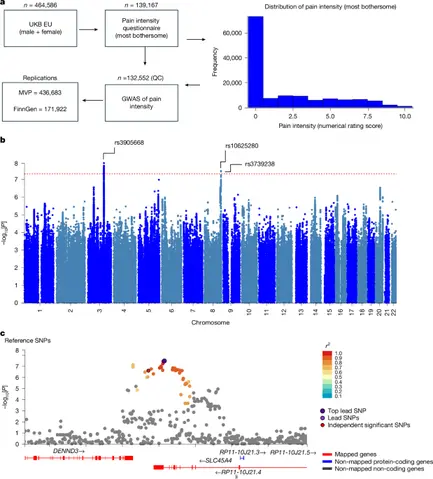T4K3.news
SLC45A4 and pain link discovered
Genetic data connect SLC45A4 to pain intensity, with mouse data supporting a role in nociception and potential for new therapies

A genetic study ties a neuronal transporter to pain intensity with mouse data showing a role in nociception.
SLC45A4 Reveals Neuronal Polyamine Transporter Linked to Pain
Researchers used the UK Biobank to study pain and found a significant link between pain intensity and variants near the SLC45A4 gene. They show that SLC45A4 acts as a plasma membrane transporter for polyamines and that a regulatory domain helps recognize these molecules. The study also provides a cryo EM view of how the transporter works at the molecular level, pointing to a mechanism for how polyamines influence nerve signals. In mice, deleting Slc45a4 leaves mechanosensation intact but reduces sensitivity to heat and chemical triggers of pain, suggesting a specific role in nociceptive pathways and heat related pain processing.
Key Takeaways
"Tiny gene, big impact on pain"
highlighting a key implication
"Polyamines now enter the pain playbook"
reflecting a shift in mechanism
"A gene level route to relief demands careful steps"
caution about translation
The work shows a clear path from a large data signal to a concrete cellular function. It strengthens the case for polyamine transport as a part of how pain signals are set in the nervous system. Yet translating this into a therapy will require care because polyamines regulate many cellular processes and a drug targeting this transporter could have wider effects. The study also relies on a predominantly European data set and animal experiments, so confirmation in diverse human populations will be important. Ethical oversight and future safety checks will matter as the field moves toward clinical tests.
Highlights
- Tiny gene, big impact on pain
- Polyamines now enter the pain playbook
- A gene level route to relief demands careful steps
- From genome to clinic the journey is long and real
Genetic pain study raises translational questions
The finding links a single gene to pain signaling, but turning this into a safe treatment will require careful testing of effects on polyamine metabolism and nervous system function. The use of UKB data and animal experiments invites ongoing scrutiny about data use and public communication.
The map from gene to treatment is long but this study marks an important waypoint
Enjoyed this? Let your friends know!
Related News

Vaping safety concerns emerge after oil buildup in lungs

Three UK cases of tropical virus linked to Brazil travel

Rising cancer rates in young women

Research links tattoos to increased cancer risk

Pope calls for peace through prayer

Young woman diagnosed with stage four colon cancer after misdiagnosis

Throat cancer linked to oral sex shocks Basingstoke man

Experts Identify Foods for Migraine Relief
